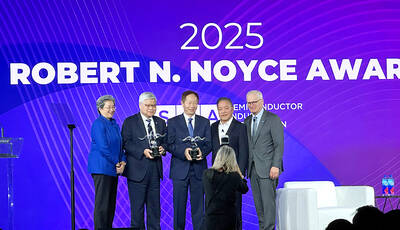Innolux Corp (群創), the world’s No. 3 LCD panel maker, yesterday said that it expects about 75 percent of it production lines to be automated by the end of this year, helping it cut manufacturing costs to competitive levels.
With most of its factories using robotic arms and machines operating in the dark, Innolux said that it is planning to cut its headcount to 50,000 this year, from 100,000 in 2007 when the automation program started.
The program aims to solve labor shortage problems, improve product quality and drive down manufacturing costs, Innolux honorary chairman Tuan Hsing-chien (段行建) told a news conference yesterday.
Tuan is the chief architect of the program.
“Wages have been rapidly increasing in China,” Tuan said. “Without factory automation systems, it will be difficult to check labor costs.”
Tuan doubles as a display consultant to Hon Hai Technology Group (鴻海科技集團) and also advises Hon Hai’s Japanese subsidiary, Sharp Corp, on the improvement of its production lines.
Innolux is a panel manufacturing arm of Hon Hai, which is known as Foxconn Technology Group (富士康科技集團) outside of Taiwan.
“Most of our production lines will be run automatically this year, with between about 25 to 30 percent of the work still being performed by human workers,” Tuan said.
“We cannot remove people from the production lines entirely, as we still need them to handle tasks in a flexible manner,” he said.
As Innolux has been using robotic arms and carts to assemble and transport displays for tablets and notebook computers on the factory floor, it said it plans to duplicate its success in transforming its TV assembly lines into “smart” production lines this year.
Innolux also plans to gradually elevate its factory automation levels further by utilizing sensors, big data and artificial intelligence (AI), Tuan said.
Over the past 10 years, Innolux has spent billions of dollars to revamp and automate its manufacturing lines, the company said.
The panel maker has assembled a 500-strong team for the automation program.
Innolux also yesterday gave an update for its new-generation display technology, active-matrix (AM) miniLED.
Innolux aims to use the cost-effective technology to compete with expensive OLED technology dominated by South Korean rivals.
“Automakers were excited about the technology when we showcased our first miniLED at the CES, because the technology is more affordable and more reliable” than OLED, Ting Chin-lung (丁景隆), head of the company’s technology development center, told reporters yesterday.
The company is scheduled to unveil its new miniLED products in June and will start supplying the displays to automakers within the next two years, given a longer product qualification period for products used in vehicles, Ting said.
Innolux is also exploring new applications to use the display technology, Ting said.

Shiina Ito has had fewer Chinese customers at her Tokyo jewelry shop since Beijing issued a travel warning in the wake of a diplomatic spat, but she said she was not concerned. A souring of Tokyo-Beijing relations this month, following remarks by Japanese Prime Minister Sanae Takaichi about Taiwan, has fueled concerns about the impact on the ritzy boutiques, noodle joints and hotels where holidaymakers spend their cash. However, businesses in Tokyo largely shrugged off any anxiety. “Since there are fewer Chinese customers, it’s become a bit easier for Japanese shoppers to visit, so our sales haven’t really dropped,” Ito

The number of Taiwanese working in the US rose to a record high of 137,000 last year, driven largely by Taiwan Semiconductor Manufacturing Co’s (TSMC, 台積電) rapid overseas expansion, according to government data released yesterday. A total of 666,000 Taiwanese nationals were employed abroad last year, an increase of 45,000 from 2023 and the highest level since the COVID-19 pandemic, data from the Directorate-General of Budget, Accounting and Statistics (DGBAS) showed. Overseas employment had steadily increased between 2009 and 2019, peaking at 739,000, before plunging to 319,000 in 2021 amid US-China trade tensions, global supply chain shifts, reshoring by Taiwanese companies and

Taiwan Semiconductor Manufacturing Co (TSMC) Chairman C.C. Wei (魏哲家) and the company’s former chairman, Mark Liu (劉德音), both received the Robert N. Noyce Award -- the semiconductor industry’s highest honor -- in San Jose, California, on Thursday (local time). Speaking at the award event, Liu, who retired last year, expressed gratitude to his wife, his dissertation advisor at the University of California, Berkeley, his supervisors at AT&T Bell Laboratories -- where he worked on optical fiber communication systems before joining TSMC, TSMC partners, and industry colleagues. Liu said that working alongside TSMC

TECHNOLOGY DAY: The Taiwanese firm is also setting up a joint venture with Alphabet Inc on robots and plans to establish a firm in Japan to produce Model A EVs Manufacturing giant Hon Hai Precision Industry Co (鴻海精密) yesterday announced a collaboration with ChatGPT developer OpenAI to build next-generation artificial intelligence (AI) infrastructure and strengthen its local supply chain in the US to accelerate the deployment of advanced AI systems. Building such an infrastructure in the US is crucial for strengthening local supply chains and supporting the US in maintaining its leading position in the AI domain, Hon Hai said in a statement. Through the collaboration, OpenAI would share its insights into emerging hardware needs in the AI industry with Hon Hai to support the company’s design and development work, as well